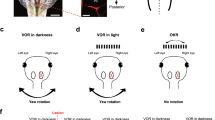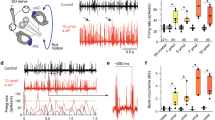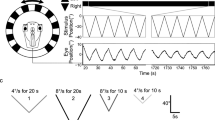Summary
Acute hemilabyrinthectomized tadpoles of the Southern Clawed Toad (Xenopus laevis), younger than stage 47 (about 6 days old), perform no static vestibulo-ocular reflex (Fig. 1). Older acute lesioned animals respond with compensatory movements of both eyes during static roll. Their threshold roll angle, however, depends on the developmental stage. For lesioned stages 60 to 64, it is 75° while stage 52 to 56 tadpoles respond even during a lateral roll of 15° (Figs. 1 and 2). Selective destruction of single macula and crista organs revealed that the static vestibulo-ocular reflex is evoked by excitation of the macula utriculi (Figs. 3 and 4) even in young tadpoles.
The results demonstrate that bilateral projections of the vestibular apparatus must have developed at the time of occurrence of the static VOR, that during the first week of life the excitation of a single labyrinth is subthreshold (Fig. 1). We discuss the possibility whether the loss of the static VOR during the prometamorphic period of life (Fig. 2) is caused by increasing formation of multimodal connections in the vestibular pathway.
Similar content being viewed by others
Abbreviations
- α :
-
eye angle
- γ :
-
roll angle
- α(γ) :
-
response characteristic
- A :
-
response amplitude
- G :
-
response gain
- VOR :
-
vestibulo-ocular reflex
References
Anniko M (1983) Embryonic development of vestibular sense organs and their innervation. In: Romand R (ed) Development of auditory and vestibular systems. Academic Press, New York London, pp 375–423
Ashton JA, Boddy A, Donaldson IML (1984) Input from proprioceptors in the extrinsic ocular muscles to the vestibular nuclei in the giant toad,Bufo marinus. Exp Brain Res 53:409–419
Brodal A (1974) Anatomy of the vestibular nuclei and their connections. In: Kornhuber HH (ed) Vestibular system. Part I: Basic mechanisms (Handbook of sensory physiology, vol VI/1) Springer, Berlin Heidelberg New York, pp 239–352
Dieringer N, Cochran SL, Precht W (1983) Differences in the central organization of gaze stabilizing reflexes between frog and turtle. J Comp Physiol 153:495–508
Gacek RR (1980) Neuroanatomical correlates of vestibular function. Ann Oto-Rhinol-Laryngol 89:2–5
Hess BJM, Precht W (1984) Identification of vestibular sense organs responsible for maculo-utricular reflexes in the frog. Exp Brain Res 55:570–573
Hillman DE (1976) Morphology of peripheral and central vestibular systems. In: Llinás R, Precht W (eds) Frog neurobiology. Springer, Berlin Heidelberg New York, pp 452–480
Horn E, Lang HG, Rayer B (1986) The development of the static vestibulo-ocular reflex in the Southern Clawed Toad,Xenopus laevis. I. Intact animals. J Comp Physiol A 159:869–878
Ito M, Nisimaru N, Yamamoto M (1976a) Pathways from the vestibulo-ocular reflex excitation arising from semicircular canals of rabbits. Exp Brain Res 24:257–271
Ito M, Nisimaru N, Yamamoto M (1976b) Postsynaptic inhibition of oculomotor neurons involved in vestibulo-ocular reflexes arising from semicircular canals of rabbits. Exp Brain Res 24:273–283
Matesz C (1979) Central projection of the VIIIth cranial nerve in the frog. Neuroscience 4:2061–2071
Nieuwkoop PD, Faber J (1975) Normal table ofXenopus laevis (Daudin). Hubrecht Laboratory, Utrecht
Paterson NF (1948) The development of the inner ear ofXenopus laevis. Zool Soc (Lond) 119:269–291
Precht W (1976) Physiology of the peripheral and central vestibular system. In: Llinás R, Precht W (eds) Frog neurobiology. Springer, Berlin Heidelberg New York, pp 481–512
Precht W (1978) Neuronal operations in the vestibular system. Springer, Berlin Heidelberg New York
Rayer B, Cagol E, Horn E (1983) Compensation of vestibular induced deficits in relation to the development of the Southern Clawed Toad,Xenopus laevis Daudin. J Comp Physiol 151:487–498
Romeis B (1968) Mikroskopische Technik. Oldenburg, München Wien
Sachs L (1974) Angewandte Statistik. Springer, Berlin Heidelberg New York
Schöne H (1964) Über die Arbeitsweise der Statolithenorgane bei Plattfischen. Biol Jahrheft 4:135–156
Shelton PMJ (1970) The lateral line system at metamorphosis inXenopus laevis Daudin. J Embryol Exp Morphol 24:511–524
Will U, Luhede G, Görner P (1985a) The area octavo-lateralis inXenopus laevis. I. The primary afferent projections. Cell Tissue Res 239:147–161
Will U, Luhede G, Görner P (1985b) The area octavo-lateralis inXenopus laevis. II. Second order projections and cytoarchitecture. Cell Tissue Res 239:163–175
Author information
Authors and Affiliations
Rights and permissions
About this article
Cite this article
Horn, E., Mack, R. & Lang, H.G. The development of the static vestibulo-ocular reflex in the Southern Clawed Toad,Xenopus laevis . J. Comp. Physiol. 159, 879–885 (1986). https://doi.org/10.1007/BF00603741
Accepted:
Issue Date:
DOI: https://doi.org/10.1007/BF00603741




